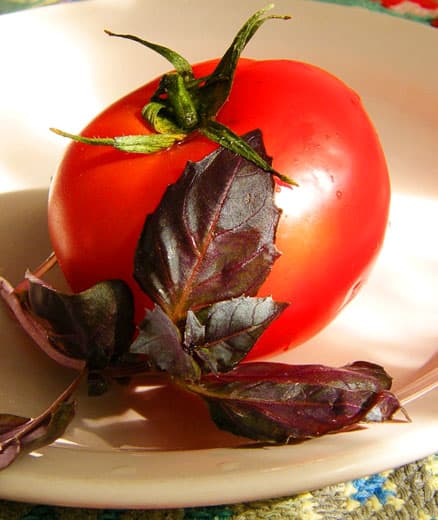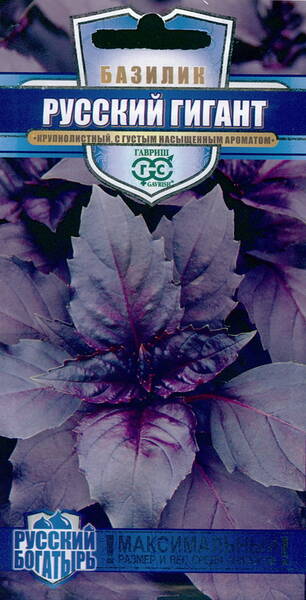A fragrance fit for kings!
Mid-season (from germination to technical ripeness 65-70 days) variety with very large wide dark purple leaves. Due to the high content of essential oils, the plant has a thick, rich aroma and taste with light notes of cloves. Used as salad greens, seasoning for meat and fish dishes.
Forms a compact bush, 30-40 cm high, with elongated, ovate leaves.
The variety is suitable for pot culture and looks very attractive in the kitchen interior.
Grow by seedlings or direct sowing in open ground. Sowing of seedlings is carried out in late March - early April. Sowing in the ground in May or early June. Planting seedlings in the ground - early June. Planting pattern 30x30 cm. Prefers well-structured, humus-rich soils. Needs regular watering.

* Basil is a delicious seasoning for dishes.
An annual plant rich in essential oils, salts, vitamins B2, PP, carotene. Large leaves and young shoots are richly colored. They are removed before mass flowering begins. In fresh or dried form, it is an excellent spicy seasoning for salads and meat dishes.
Growing conditions.
The culture is demanding of heat, light and moisture. Cultivation by seedlings is recommended. At an optimal temperature of +20+25°C, seedlings appear in 10-15 days. Planting in open ground when the threat of frost has passed. For growth, well-drained loamy soils rich in organic matter, protected from cold winds, are preferred.
* In the legends and traditions of a number of peoples, basil is mentioned as a symbol of love, immortality and family happiness. The homeland of this plant is Eastern India, where it has long been cultivated as a spicy and medicinal plant. Basil wreaths have even been found in the tombs of the pharaohs of ancient Egypt. It came to Europe from the countries of the East (16th century) and quickly became a favorite spice.
The strong pleasant smell of basil is due to the presence of an essential oil of complex composition, the content of which ranges from 0.02% to 1.0%. It is formed and accumulates in glandular hairs on the leaves and calyx of the flower. In addition, basil also contains sugars, carotene, phytoncides, vitamins C, B2, PP, and rutin. It contains 2 times more ascorbic acid than parsley. Basil greens are used as a seasoning for meat, fish, vegetable dishes, sauces and salads. Dry leaf powder replaces allspice.
Basil is valued not only as a spice, but also as a medicinal plant. In folk medicine it is used as an anthelmintic, antifever, antitussive, and diuretic disinfectant. When consumed, breastfeeding mothers increase milk production. In medical practice, basil is used to improve stomach function, increase appetite, for gargling and in various compresses. In French herbal medicine it is known as an antispasm.
Please note that: the leaves are rich in essential oils and have a strong, pleasant odor. Fresh leaves are a valuable source of carotene and rutin.
Fresh and dried leaves are good as a seasoning for fish and meat dishes, sauces, and salads. The leaves can be used in canning vegetables and for flavoring confectionery.












